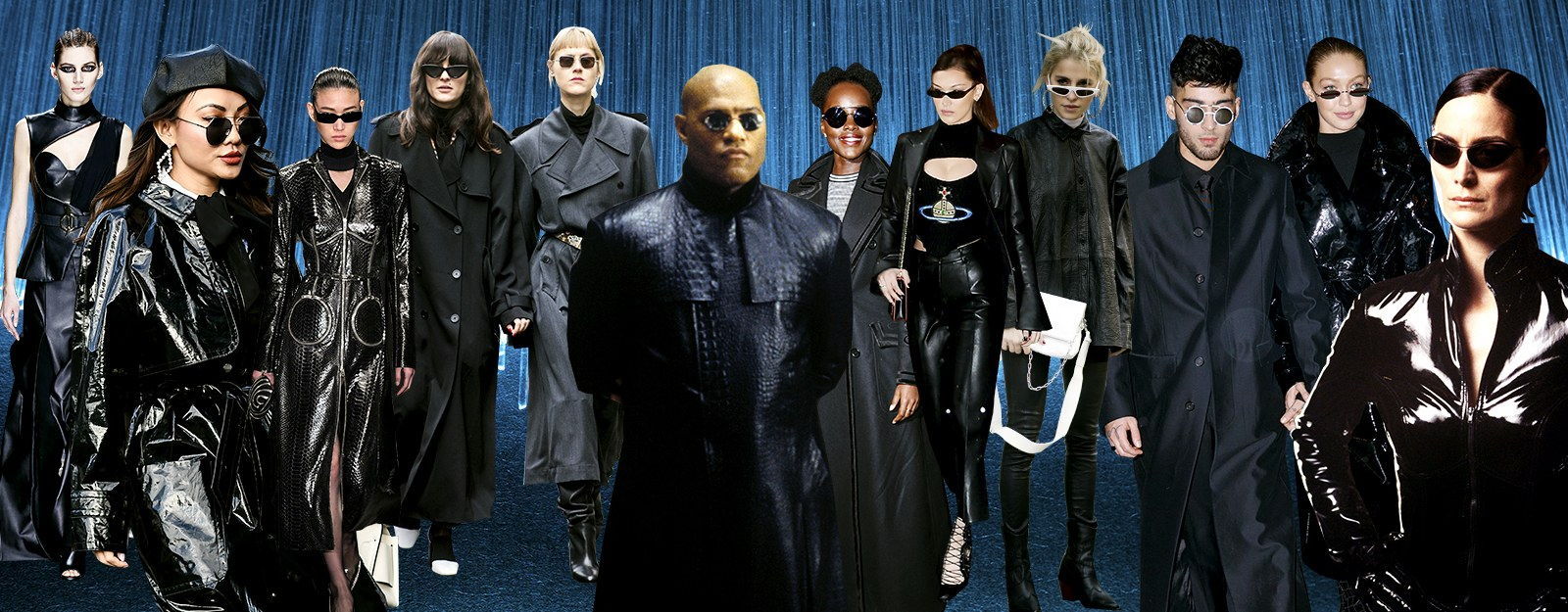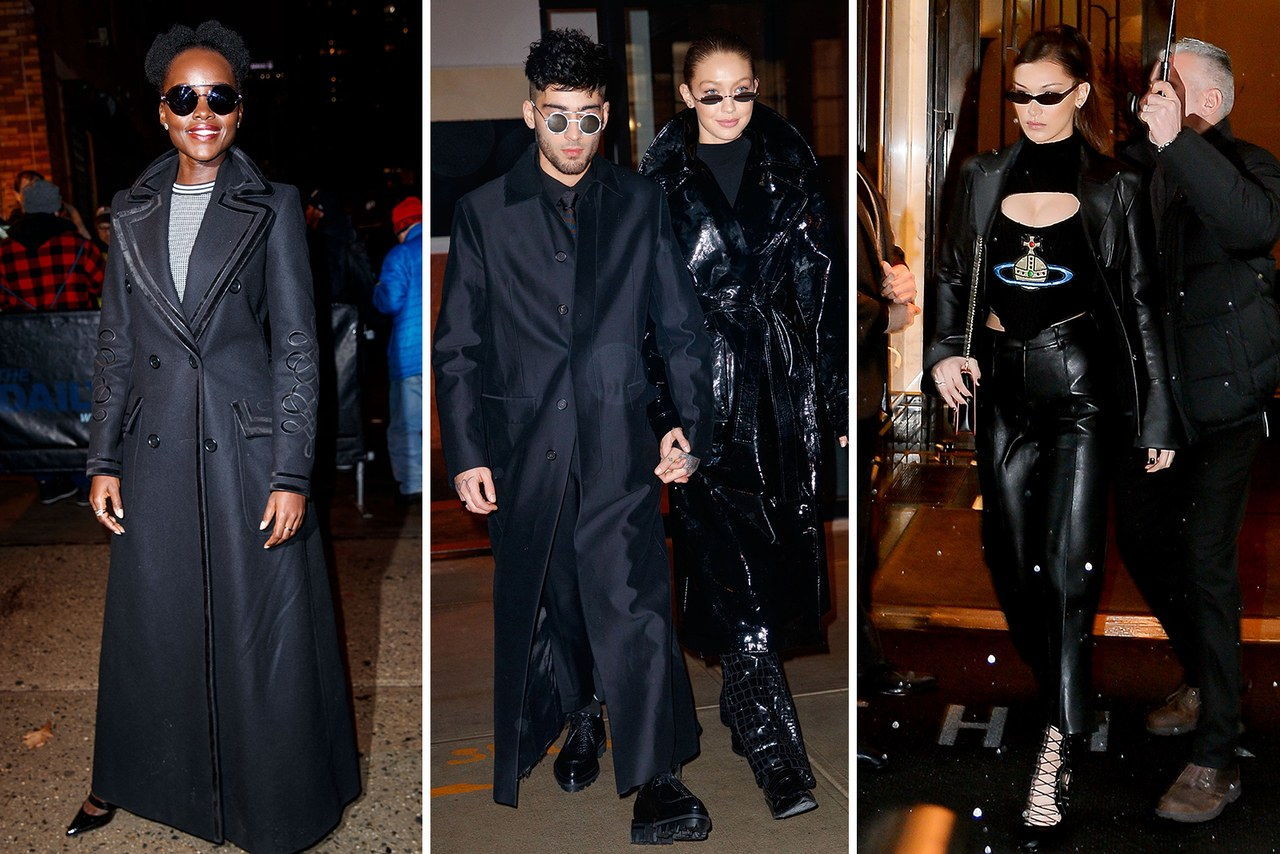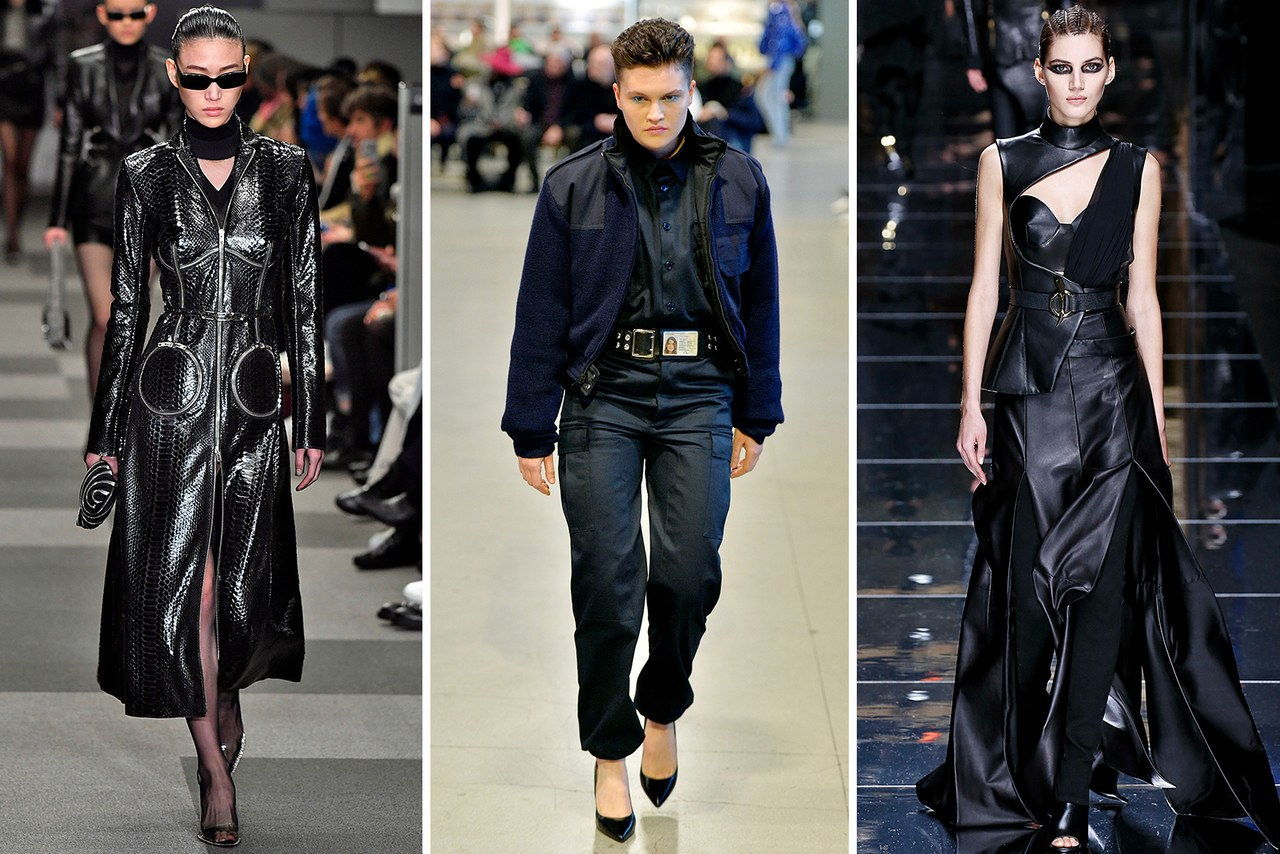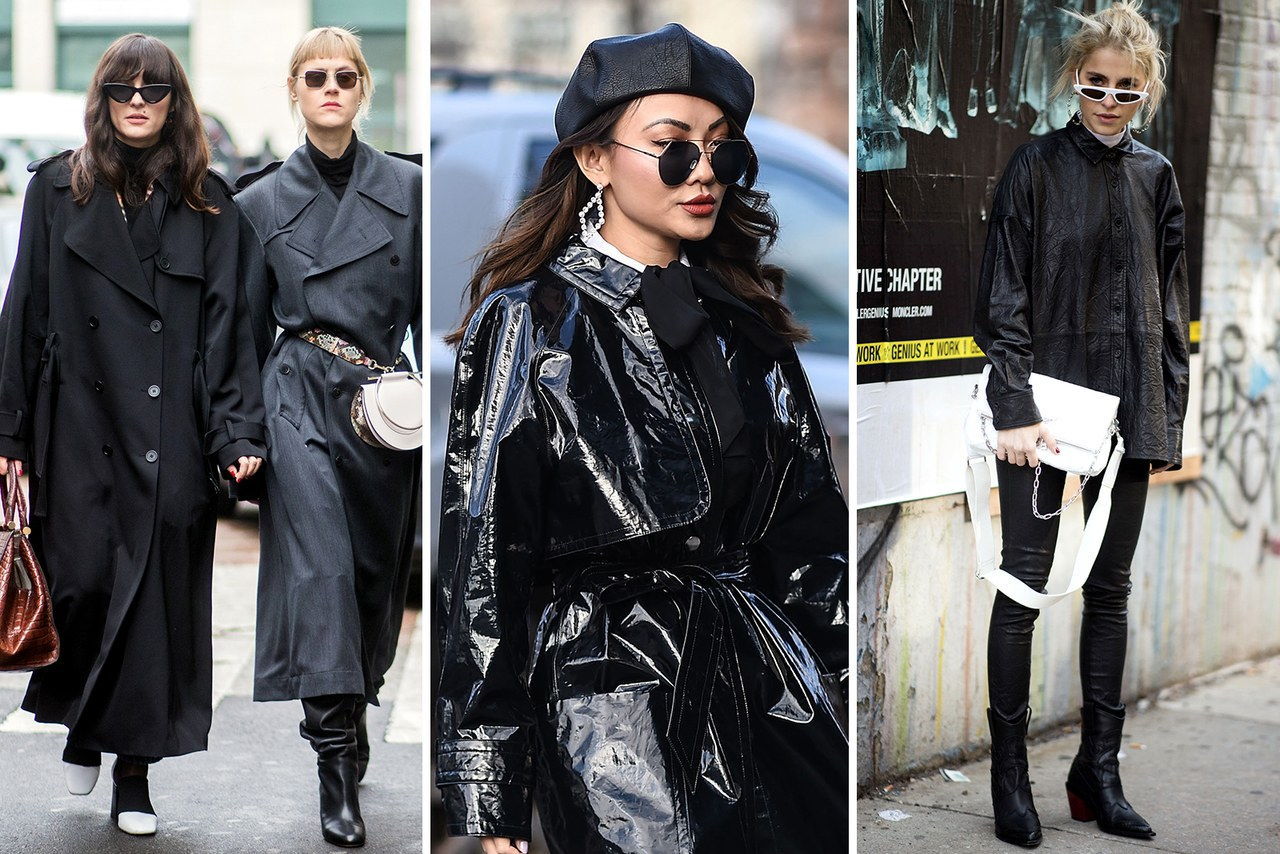Why Everyone Suddenly Looks Like They Stepped Out of ‘The Matrix’

Look at all the runways and recent street style images, and you’ll likely be reminded of a series of iconic ‘90s characters: Cher Horowitz of Clueless, Carrie Bradshaw of Sex and the City,…and Neo, Trinity, and Morpheus of The Matrix. And no, your eyes aren’t deceiving you: The 1999 action sci-fi blockbuster is turning out to be the fashion film of 2018.
Over time, the Wachowski-siblings-directed series has come to embody the late ‘90s zeitgeist—not only because of its iconic cast and now meme-able moments, but also because of its strong visual language. At the first mention of The Matrix, we see Keanu Reeves, Carrie-Anne Moss, and Laurence Fishburne (who played the aforementioned trio) in their floor-grazing trench coats, patent leather, combat boots, and tiny sunglasses. That uniform is to the franchise what Cher Horowitz’s little plaid set was to Clueless. And though both films had a distinctive (albeit vastly different) role in defining ‘90s fashion, The Matrix never really achieved the same mainstream appeal or the sartorial clout the way Clueless had…until now, that is.
Seemingly out of nowhere, all the most-followed, most paparazzi-snapped stars—Kendall Jenner, Bella and Gigi Hadid, and Kim Kardashian, to name a few—followed by a flood of street-style stars, have begun to dress like they’re on the set of a Matrix reboot. Sure, we knew the Wachowskis-created worlds (a machine-made virtual construct versus a post-apocalyptic reality set in the year 2199) to have a pretty vast fan base, seeing as the film earned $27 million on opening weekend and went on to gross $463 million worldwide. But to come back 20 years later as the inspiration for 2018’s most ubiquitous trend?

From left: Lupita Nyong’o; Zayn Malik and Gigi Hadid; Bella Hadid.
The resurgence of the Matrix aesthetic can be traced to the fall 2017 shows, when Demna Gvasalia sent out voluminous trenches paired with skinny sunglasses at Balenciaga and floor-grazing leather coats at Vetements. That same season, there were similar all-leather looks spotted on the runway at Balmain and Alexander McQueen. Fast-forward to fall 2018, and Alexander Wang presented his own take with a Working Girl meets The Matrix collection, with power suits styled with futuristic shades in New York; meanwhile, in Paris, Virgil Abloh sent out dual-leather dresses, complete with (you guessed it) sleek angular eyewear at Off-White.
Kym Barrett, the costume designer who created The Matrix’s signature wardrobe, says she had no idea that her creations would have such an immense impact—let alone one so lasting that they’ve made their way back to the public consciousness nearly two decades later.
“I was trying to tell a story about what it would be like to live in that world,” she tells Glamour. “I never had a hard number on when in the future it was set, but I wanted it to feel like it was in a world of bigger possibility, and now we are in that world.”

From left: Alexander Wang Fall 2018, Vetements Fall 2017, Balmain Fall 2017.
The movie was filmed in Australia, which Barrett describes as being “in our little bubble trying to create a world, a distant world that wasn’t really connected to the fashion at the time.” Still, the climateof the era inevitably touched the wardrobing. “It was the ‘90s and everything was bleak and monochromatic, so I think without purposefully trying to use fashion as a touchstone, I was still subconsciously connected to it.” Barrett remembers it as a period that was “quite repressive, dark, and a bit gloomy”—the U.S. was dealing with the fallout of the Clinton-Lewinsky scandal; we were approaching the new millennium, and with it a whole host of doomsday scenarios, including the Y2K scare and an end-of-the-world mindset.
For Barrett, it was of the utmost importance to have the costumes for The Matrix reflect the duality of the post-apocalyptic and the computer-simulated realms. The clothing of the real world should feel organic (she had the crew’s mothers and grandmothers form a knitting circle to make all the sweaters by hand to achieve that), while that of the Matrix should feel slightly more sterile. “When Neo says he needs guns, all of a sudden he’s wearing an outfit that could accommodate more guns [in the Matrix]—his look wasn’t made by somebody, it’s a construct,” she explains. “The first time I read the script, I felt like [the Matrix] was a shadow world and people would disappear and reappear, so they needed to have an oil-slick, high-contrast, reflective look, as though you were tricked: Is she there? Is she not there?” (That explains why Trinity was outfitted in high-shine patent for her action-packed scenes, for instance.)
Because she had to work within a lean budget, Barrett says she couldn’t afford to dress Moss in real leather; the actress was in stretchy PVC for the majority of the film, which in the end was most conducive for her kickass stunts. Textile sourcing was pretty creative across the board: Barrett hunted down end rolls of designer fabrics, scrapping together enough to make something work. (Neo’s trench is actually a cheap synthetic printed to look as though it’s crafted from wool, but the fabric’s fluid nature gave his fighting scenes a neat billowy effect).

From left: Morpheus, Neo, and Trinity in The Matrix.
No talk of The Matrix fashion in 2018 would be complete without mention of the sunglasses—those tiny, now-infamous accessories that Kanye West apparently emails about. Barrett says she really can’t say whether the film spawned the slim-frame eyewear trend of the ‘90s, but the shades served a critical role within the film’s universe. “The characters are awake in the Matrix—they’re the only ones who know the truth, so the sunglasses were a way to hide their eyes, to hide who they truly were, from everyone else.”
The Matrix’s relationship to the fashion industry actually goes back to the time of the premiere. The film had an immediate, noticeable impact on both the red carpet (most famously, Janet Jackson at the 2000 MTV Movie Awards) and on the runway. John Galliano was the first designer to go on the record to say his collections—specifically, the fall 1999 haute couture season he created for Dior—were deeply inspired by The Matrix. Vera Wang was next, with her primarily black fall 2000 ready-to-wear assortment, with many pieces that felt reminiscent of Morpheus’ uniform. According to experts at the time, The Matrix contributed to the revival of trench coats in fashion: “The costumes’ clean, straight lines, very pared down, dovetail with a renewed interest in minimalism,” Ed Burstell, general manager of Henri Bendel, previously told The New York Times in 2003.
Jump forward to 2018, and Barrett muses that there are deeper undertones to the film’s revival in this particular space. “I do think The Matrix is back in fashion because we’re in a revolution,” she says. “The strongest characters in The Matrix are women—they had a job to do, they needed to have clothes they could work in and look good in, and we’re starting to see that utilitarianism in fashion.”

“I think Trinity resonates the most because she’s what we want feminism to be—she’s revolutionary, she doesn’t give up on her beliefs, she stands up to convention and against those who are trying to take away humanity,” Barrett continues. “And she’s also super feminine in how she dresses. I think the strength of the women in The Matrix is being highlighted in the same way it’s being highlighted in women in society now.”
When Neo, Trinity, and Morpheus fight the agents in the Matrix, their costumes serve in some ways as a coat of armor. Given the current state of affairs—in our communities, in our country, and abroad—maybe that’s all we want: to feel safe and shielded. “I think one of fashion’s greatest attributes is that it can track and predict the revolution that’s coming,” Barrett says. “I see echoes of today in The Matrix, which I think is really cool. It’s really great to have people see how I saw the world, and I’m happy that this movie stands the test of time—I’m really proud to have been a part of it.”

